
Chair of Graduate Fine Arts
Peter Simensky
Susanne Cockrell
Thesis Advisors
Maria Porges
Karen (Ren) Fiss
Exhibitions Advisors
Peter Simensky
Glen Helfand
Aaron Gach
Editors
Lynse Cooper
Yue Xiang
Dottie Lo Bue
Kelley Finley
Willow
Design
Xinling Wang
Yishi Chen
Essayist
Sloane Holzer
Kelley Finley 5
Deena Qabazard 7
deenamachina.com / @deenamachina
Seven Chen 9
Carrie Han 11 @jingyi.art
Yue Xiang 13
kelleyfinley.com / @kyfin @seven chenn xiang-yue-art.com / @xiangyuecreates
Xianghan Cheng 15
@chengcxh
John Furth 17
@johnfurthart
Jesse Muñoz 19 @jmoonartwork
Duma Mock 21 danielmock.com / @mockthings
Jason Stern 23
Dottie Lo Bue 25 dottielobue.com / @dottielll
Gene VanWyk 27 genevw.com / @green bean gene
Xiaohan Zhou 29
Molly Barker 31 mollybarkerart.com
Peipei Li 33 popos.world / @popo.art
Lynse Cooper 35
lynse-cooper-photo.com
Willow 37 26willow26.art / @26willow26
Luning Ge 39 @luningart
Erica Nicole Hannel 41 ericanicolehannel.com / @ericanicolehannel
Chrissa Chorvat 43
@jason pottery achiiart.com / @achiiart chorvatart.com / @chrissachorvat
ARTISTS
DEDICATED TO our dearest PETER SIMENSKY
We are living in strange, strange times. That’s an understatement. But we always seem to be. In the many years that I have been working with MFA students, I have reflected on that same phrase when considering the graduate exhibition. A two-year program is such a distinct boundary of time, though it is a format that really does accommodate growth and bonding.
It is such a rewarding experience to see the evolution of an art practice. So much happens in four semesters. There are myriad conversations, connections, and experiences. It is something that students and faculty go through together.
In the arts, we exalt the curiosity that comes with navigating our era. An MFA program is a microcosm of exploration. In this timeframe, artists make the commitment to dive deep and be vulnerable. An MFA program relies on openness and expansion. The Class of 2024 is impressive for its strength and cohesion. This publication exists out of their pluck and sweat equity.
They did this in the face of loss, that of a revered, dedicated leader and artist, Peter Simensky. His passing in December 2023 brought us all, students and faculty, closer together in grief and dialog. Our conversations became more difficult, but also more profound. Peter was deeply in support of this catalog project, and what you hold in your hand speaks, with reverence and appreciation, to his memory.
This publication is also an expression of life and forward thinking. The graduating artists offer their work as a bridge to the future and to an enduring creative spirit. All of us who shared this experience with them can’t wait to see what they do next.
Glen Helfand Associate Professor Chair, Graduate Curatorial Practice
KELLEY FINLEY
“My work uses scale and embodiment to question the internal versus the external view of the marginalized woman’s existence. These diasporic experiences are venerated and tenderly held within the sculptural, anthropomorphic containers I make, creating a sacred space. Domestic materials like fabric, thread, and medicinal herbs actualize protection, grief, monumentalization, vulnerability, and personal shrines.”
Cheongsam
envelopes a 5’2” body
Lotus House Wishes
vinyl, thread, archival family photo, stainless steel, sewing needle
vinyl, thread, stainless steel shoulder’s peak to hip x hip to knee x one step forward through a doorway
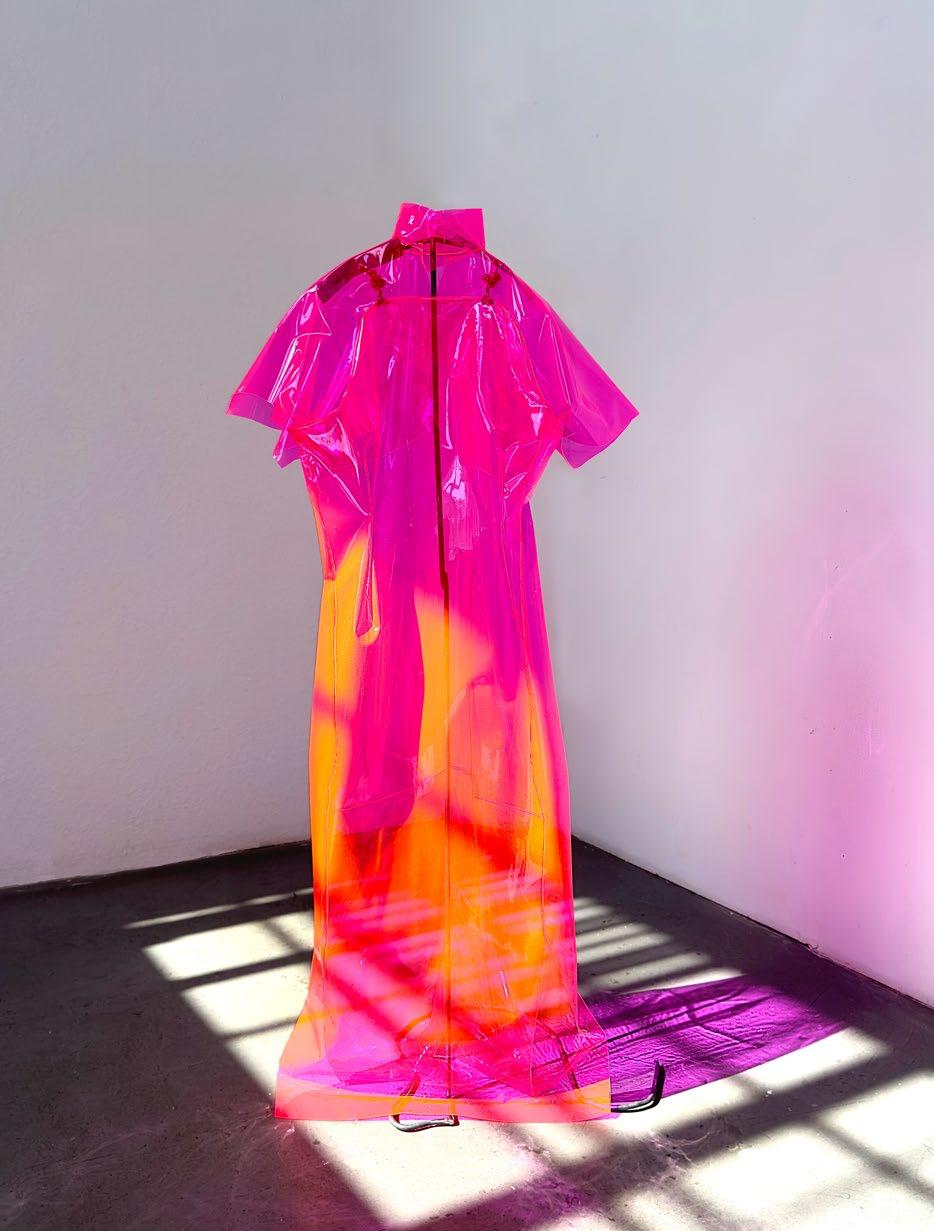

5
DEENA QABAZARD
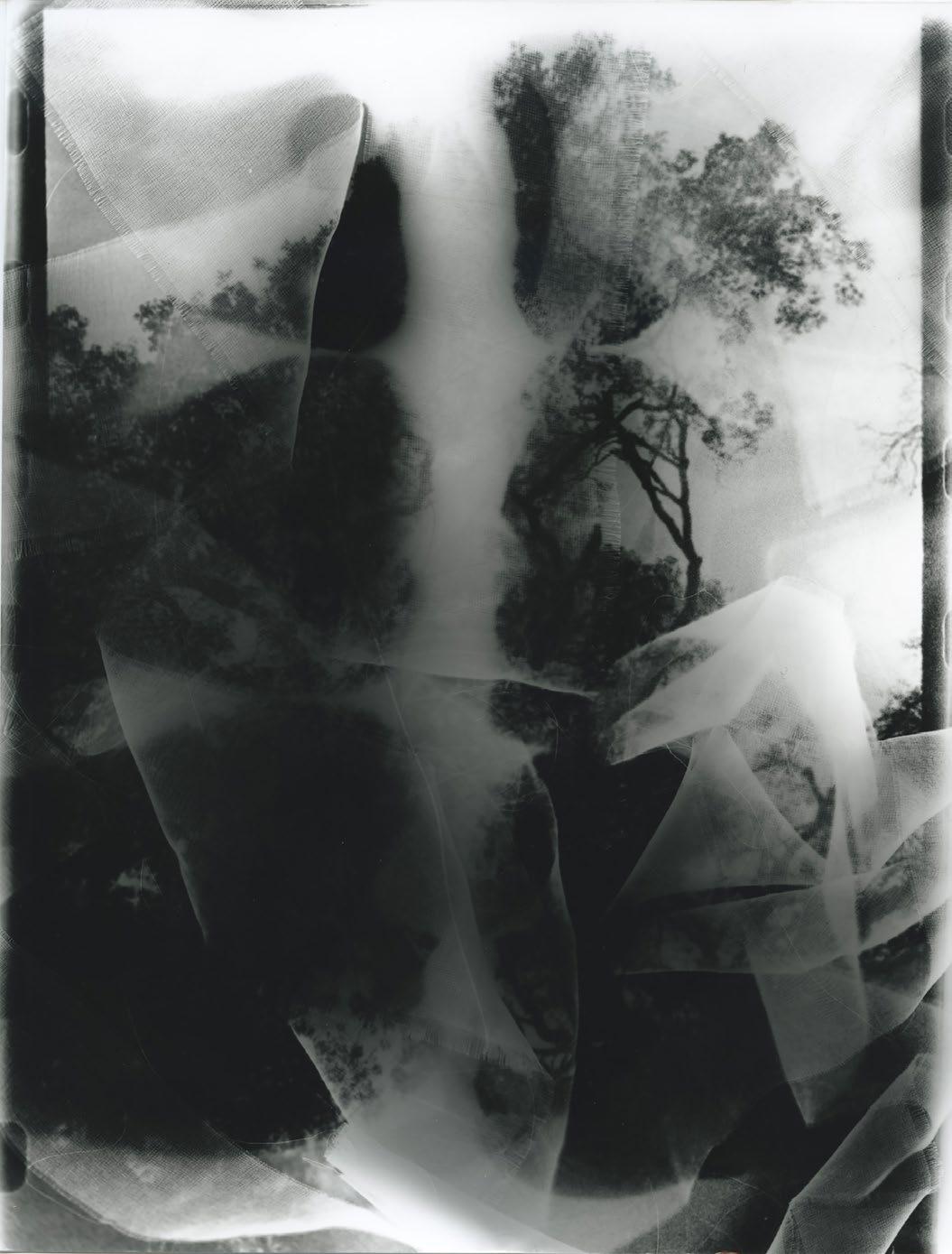
 Soft Tissue
Abyss Between Here And There
silver Gelatin Print
Soft Tissue
Abyss Between Here And There
silver Gelatin Print
silver Gelatin Print 7
8” x 10” 8” x 10”
“Artmaking is my portal between homes, memories, and landscapes. Through the act of destruction and repair, I bridge materials, my hybrid identities, my Kuwaiti American heritage, and realities of the physical body and breath.”
SEVEN CHEN
“Under the investigation of memories and mystical experiences, I’m seeking to create a personal narrative about the body and the spiritual through sculpturemaking using textile and metalsmithing.”

 Girl
Girl
9
textiles, felt, wig, copper, clay 8” x 2.5” x 40” & 3” x 3” x 8”
In The Bush inkjet print on canvas 40” x 55”
CARRIE HAN
“By enveloping and adapting my physical form to various environments, I seek solace and a heightened sense of stability. This transformative experience resembles an otherworldly second skin, concealing my own emotions and vulnerabilities.”


11
Hidden Legs wool felt 5” x 2”
Thorn wool felt 15” x 13”
YUE XIANG
“I find myself existing in borders of definitions, identities, languages, and cultures as a queer Chinese American immigrant woman. I imagine liberation through narrating my personal history.”


13
22 Performance Live Shot - Sweeping
Closure buttons, chiffon, embroidery thread, polyester thread
14’’ x 70’’ x 2’’
XIANGHAN CHENG
“Layers define my work and me. The first day when I opened my eyes, the layer started to build up.”
Right Here


15
Untitled
oil on canvas oil on canvas
36’’ x 48” 70’’ x 100“
JOHN FURTH
“I start with a bare abstract form that will stay constant, choose a digital medium to elaborate it in, and finally a physical medium in which to realize it. By varying the parameters of my projects, I encourage digital/physical ecologies to grow in different ways.”


17
Mural 1
Mural 2
gouache, ink, graphite paper, acrylic ink, pine, glitter, cork
5’ x
4’
3’6” x 2’4”
JESSE MUÑOZ

“I explore the intersection of the human experience and our reliance on technology, blending the organic and the digital, the real and the virtual.”

19
Portrait 2 (Purple and Pink) photography 25’’ x 14’’
Portrait 3 (Pink and Yellow) photography 25’’ x 14’’
DUMA MOCK
“I am creating props for an unwritten play. I am interested in creating objects that have an aura of narrative without collapsing into Story... I am drawn to the decorative, the gaudy, and the operatic; I love side chairs that were never intended to be used. I celebrate craft, queerness, and the pathetic. A technical mistake is always an opportunity for adornment; adornment is always an opportunity to be gay.”

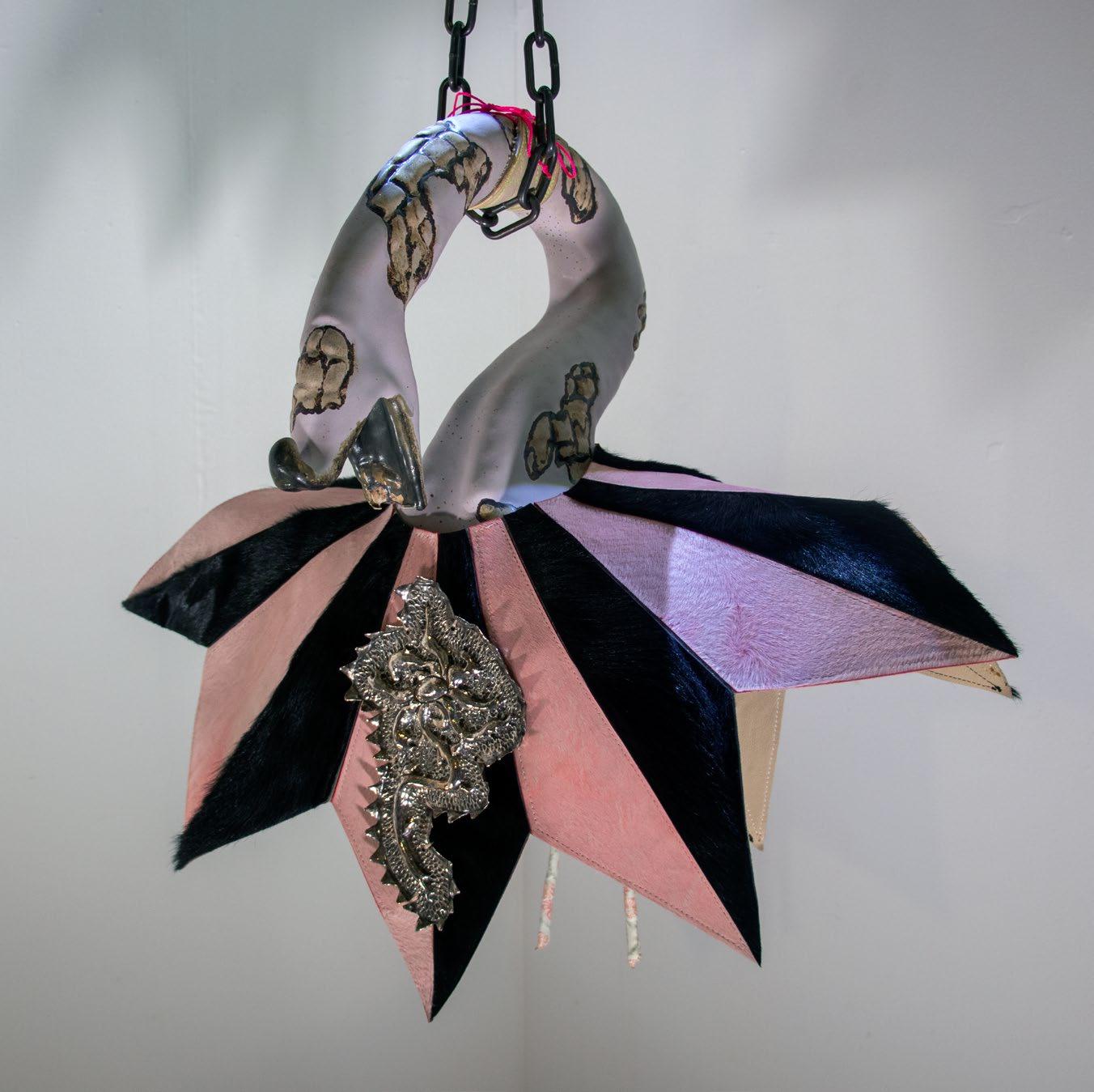
21
Yo-Yo Gear textiles, leather, felt, batting, thread, wood, shellac, paint, straps, hardware 48” x 48” x 72”
Fool’s Flower hair on hide leather, glue, thread, silver plated copper, patina, wax, ceramic, steel chain, leather, marking twine, disco ball motor
JASON STERN
“My current work is interested in the future of our natural world. I’m interested in asking questions about our environment that don’t lend themselves well to being explored through science.”
Bowl Mound
porcelain

Inharmonious Advice
watercolor on washi on brass frame
4’’ x 7”

23
bowls, foam, vibrating motor 45’’ x 45”
DOTTIE LO BUE
“My work is an invitation into the symbolic house— a fumbling examination of the house and its boundaries as metaphysical space, as worlds compressed, dismantled, and put back again. I consider it an extended search for gentleness in the places we are meant to rest safely.”


25
Nightstand
Ghost oil
oil 30” x 40”
30” x 40”
GENE VANWYK
“My work reveals the ghosts of interaction by exploring what remains when pragmatic architectural elements become ruins; both the miniature scale and the minimal content allude to what could be.”

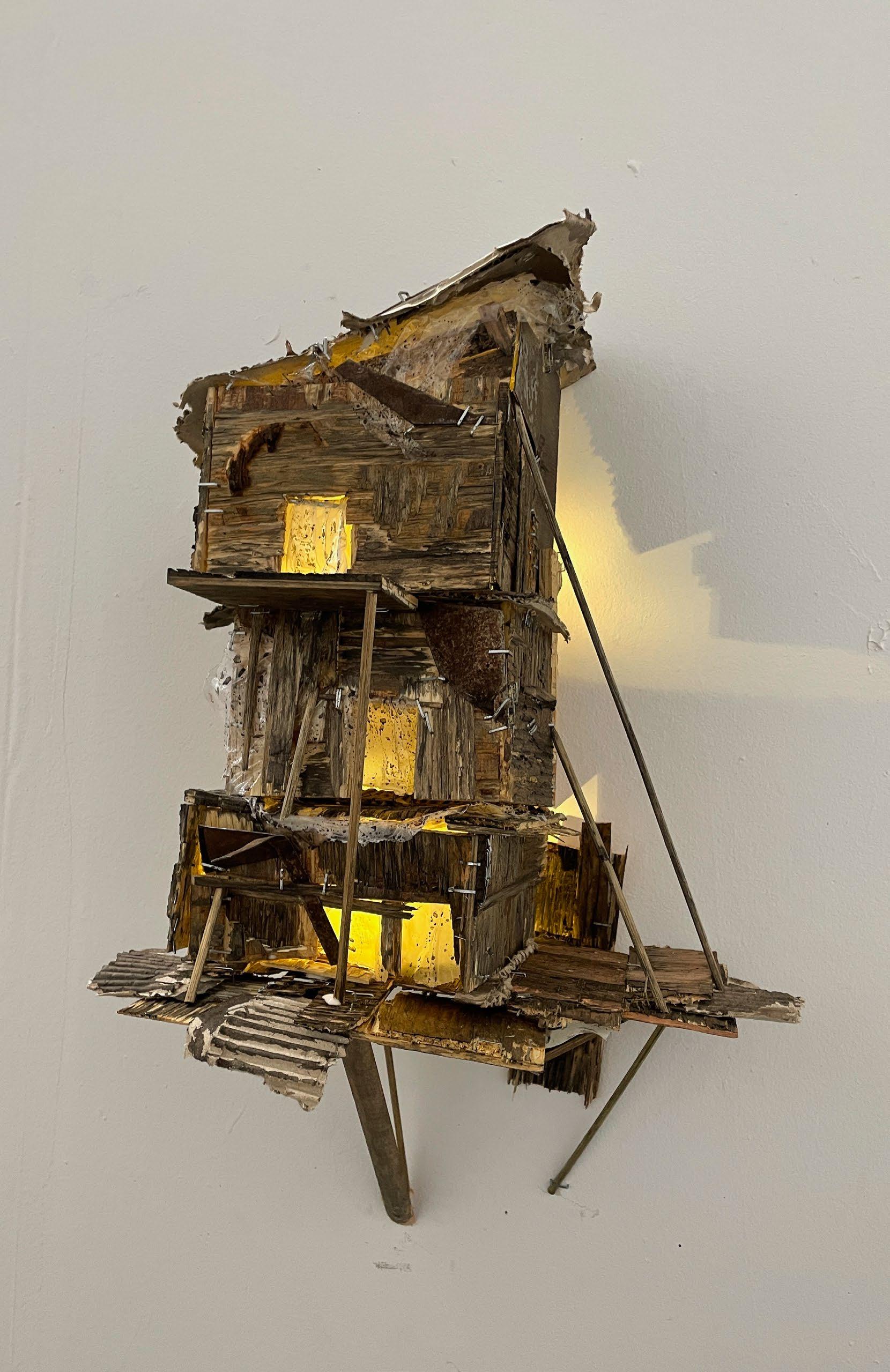
27
Untitled Sink clay, metal 1” x 1” x 1”
Scrap scrap wood, plastic, staples 10” x 8” x 8”
XIAOHAN ZHOU
“My artworks combine photographs as a representation of reality and projected components that are inspired by ethereal realms of consciousness. Through these experimental animations of the interplay between physical prints and untouchable projections, between clarity and mystery, I hope to create layers of meaning and symbolism that invite viewers to potentially unlock a perspective not yet known to them.”

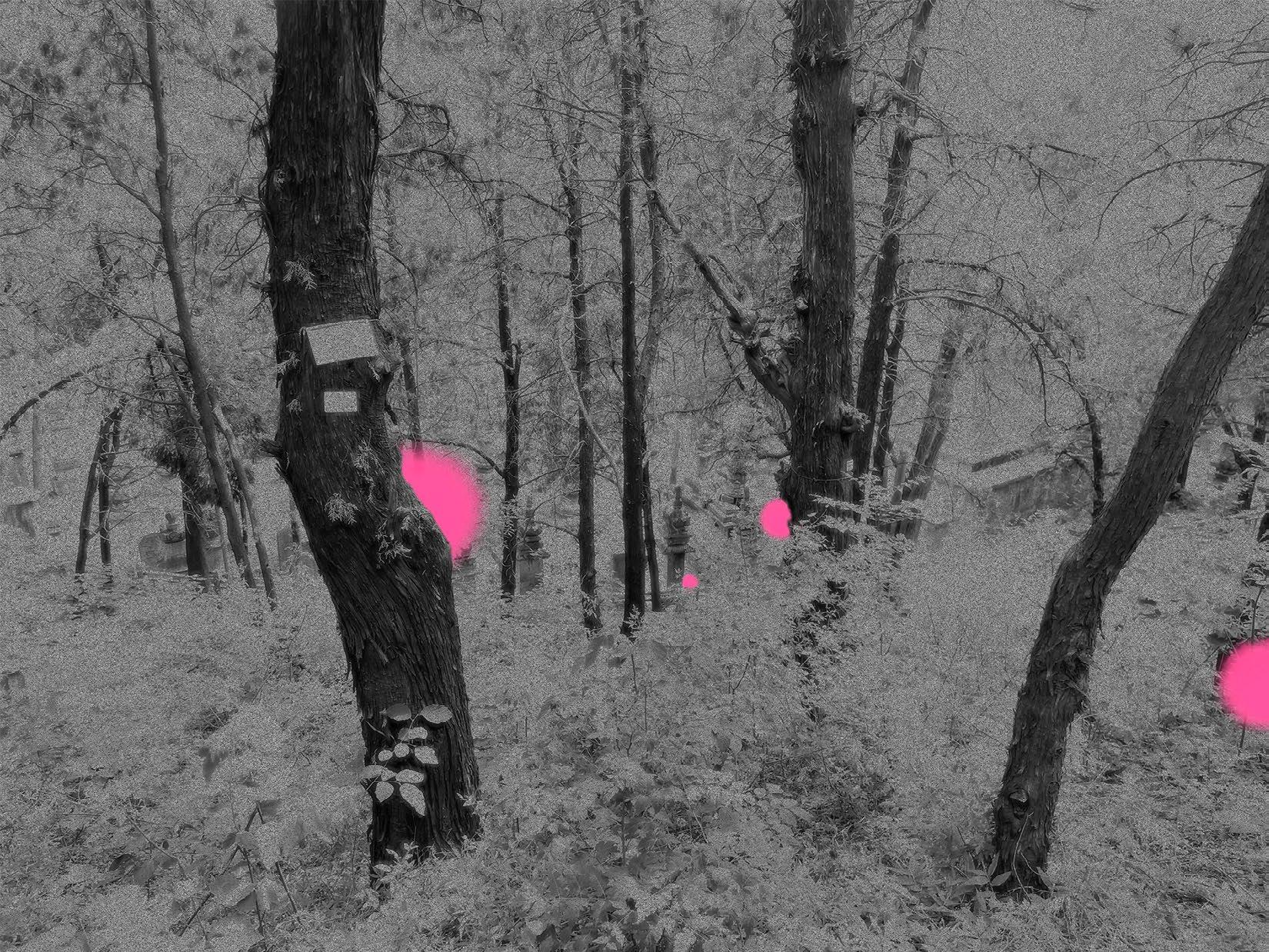
29
Dystopian Daydreams series of animated gifs
MOLLY BARKER
4 5 2023 2
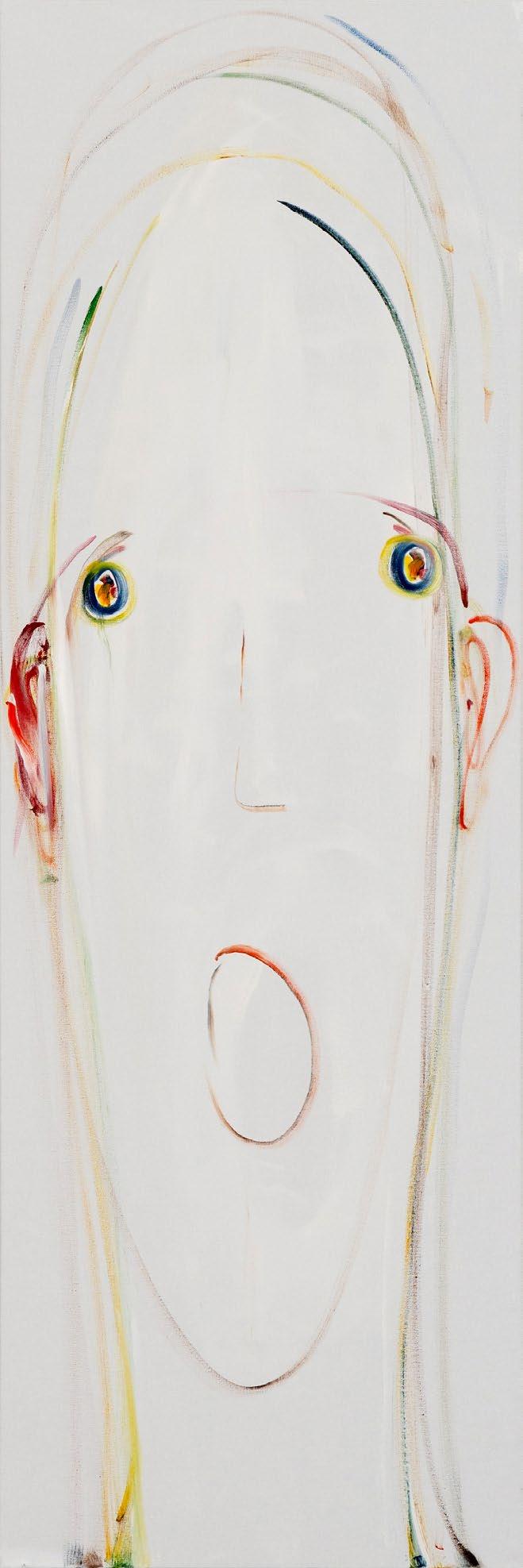
“I work with immediacy. I don’t plan or arrange, and I rarely revise. I want to see what happens.... Instead of mirrors, the paintings are sounding boards.”

4 3 2023 2 oil on linen 60” x 20”
31
oil on linen 60” x 20”
PEIPEI LI
“My figures are cryptic allegories... I am interested in the connection and relationship between people and the world, as well as the balance between people and themselves.”

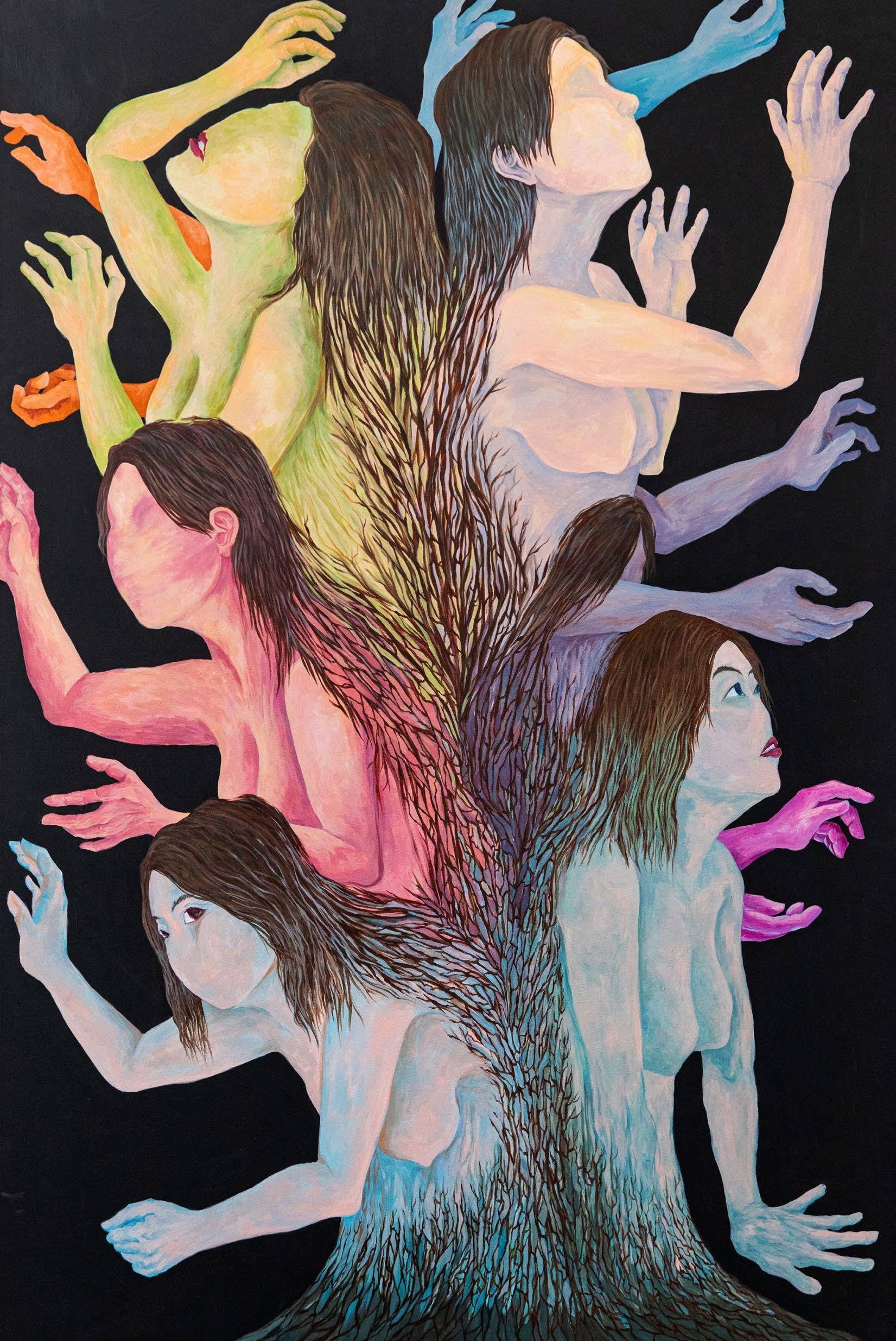
33
Family Tree HunDun acrylic acrylic 72” x 48” 96” x 72”
LYNSE COOPER
“I deal with themes of family, preservation and decay, memory, and isolation. Subject areas of interest include: the archive, chance, Black American domestic life, aesthetics, and death culture.”
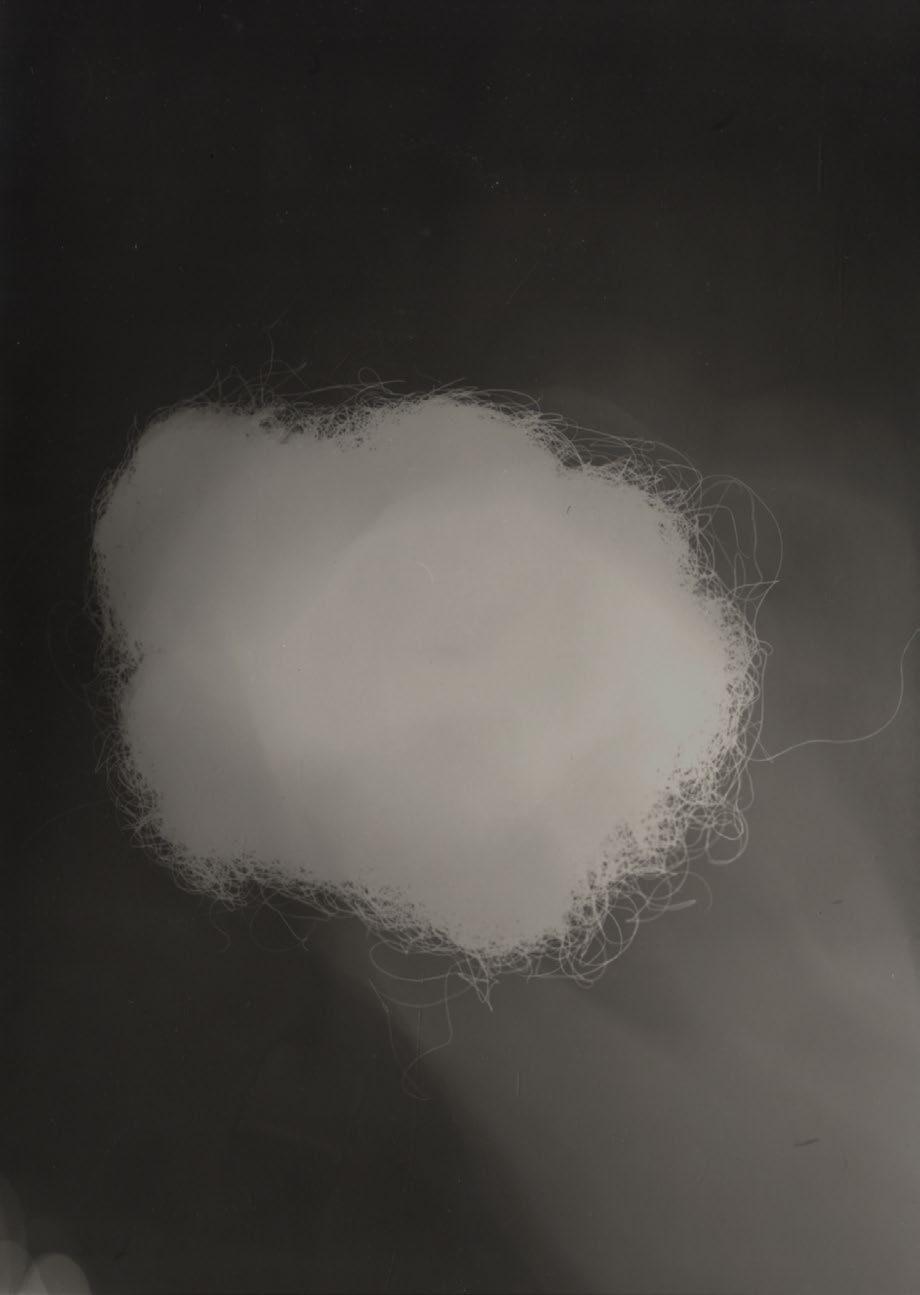

35
Cloud 3 Brothers
silver gelatin print (photogram) two silver gelatin prints (photograms)
5” x 7” 8” x 20”
WILLOW
“My work is mainly based on a visual language system composed of text and image, with the metaphorical structure of adrift and anchor, exploring and expressing the repetition of spaces and layers in experience.”
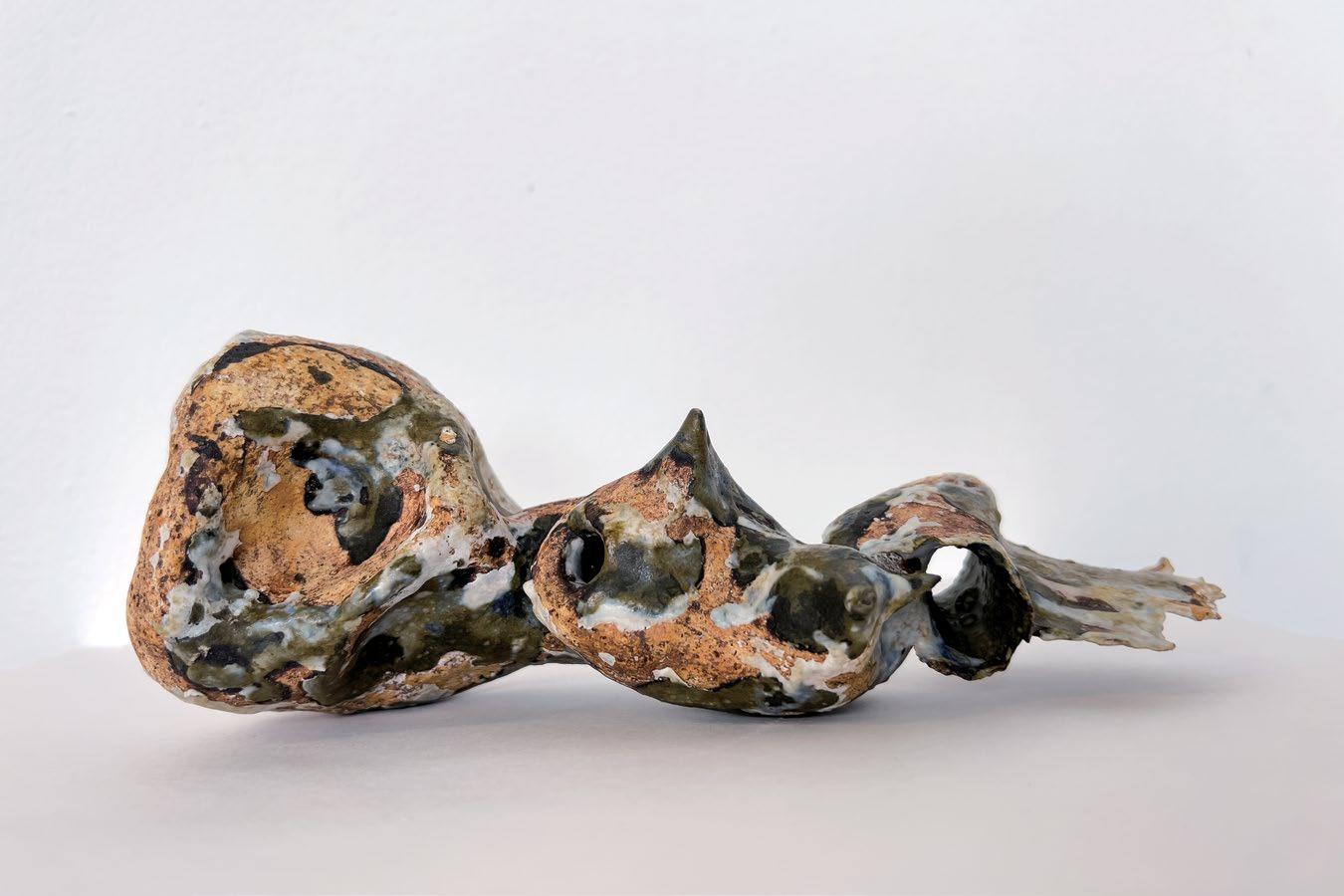

What does 3/7 mean? What does 3/5 mean?
Can they mean the same thing?
They can mean Wednesday.
How about -3/7?
A number from otherworld.
A day that passed.
A space that disappeared.
A layer that sank.
A channel that was built.
A dimension that was created.
A new space.
37
Holed Wind ceramic 8.25” x 3.625” x 3”
The Day oil on canvas 96” x 60”
LUNING GE
“My passion lies in capturing the nuances and emotions of everyday life.... The soft and dreamy colors I use aim to evoke a sense of isolation and longing.”


39
When I Look At You oil on canvas 25” x 30”
When I’m Escaping From You oil on canvas 25” x 30”
ERICA NICOLE HANNEL
“Through anachronistic visual storytelling I aim to displace us from our modern worldview, and better illuminate truth and reality, challenging our belief in these systems.”

 Battle Standard from the 3rd Crusade, Item no. 63
Battle Standard from the 3rd Crusade, Item no. 63
These Stormy Seas, Item no. 36 silk, metal, sand, wood, brass crown
collage, paint 96” x 38” x 15” 41
23” x 15.5”
CHRISSA CHORVAT
“My artwork addresses a multiplicity of personal and social issues, ranging from subjects rich in sexuality, adaptation, and political discourse as seen through eyes of social practice and seductive detournement.”


43
Light The Way polarized tape, led light 20” x 8”
Stereo Type pvc, forged steel, cotton, rubber 12” x 28”
ALTARED SELVES
Sloane Holzer
How do you ask a question in a language which does not exist?
The thought fluttered between my ears as I took in Seven Chen’s Girl. Peering at the copper rings lining the inside of the wig, I felt overwhelmed by them as a collective, their presence like condensation collecting on glass, or a collection of words birthing some new way of speaking. It seems impossible to ask a question from a place outside of language. So pretext is often used. Yet pretext is found in the categories which order life into neat, violent grids – forming our reality, our shared social lives’ gnarled roots. Culture’s borders, its divisive razorwire that we are all snared by in some way, seem more tangible than ever. Each day the lines come into sharper focus. The question of how to disrupt them takes on vital importance.
Some artists do away with lines entirely. John Furth’s Mural 1 deploys ladder and slide-like forms in a way that disperses any grid which might contain them. Bowl Mound by Jason Stern splits open chronological lines. The form is reminiscent of shellmounds, the indigenous Ohlone people’s elegiac and ceremonial structures that once dotted the Bay Area. Shellmounds, which contained ancestral remains, were advertised to early colonial settlers as fertilizer. The remaining few are buried under concrete or destroyed, like the one beneath CCA’s San Francisco campus. Stern’s work feels in a similar vein, an extant sculpture that engages in auto-archaeology – both naming the structures which exist now and illuminating what will one day disappear around us.
If there was ever a time for artwork which demands reflection rather than an easy answer, this is the moment. If there was ever a time to make a new language, stitching together elders’ wisdom, second hand advice, gossip, eavesdropped conversations, imperfect translations, and the threads of language plucked out of halfremembered dreams, now is that moment.
Interest in the undefined has often led to haunting consequences. Countless artistic movements produced the canon only by violating the opaque, refusing to consider the unknowable. Why encounter mystery when you can claim it never existed? Thinking like this flattens the world into parseable shapes, ready to be grasped.
This cohort’s work promises something new. It urgently beholds all the small details which accumulate into a life. When medieval monks, bored by endless hours of transcribing knowledge, allowed their idle minds to wander, they produced fantastical illustrations – marginalia in the space outside of the text. This cohort’s work exists there. Chrissa Chorvat considers her work a kind of “seductive detournement”, tuning the wrenches – or the industrial refuse which shades the edges of our daily experience – in order to find a truer frequency. Or consider Carrie Han’s Hidden Legs, its humor both palpable and unsettling. Han’s work is the original version of a fairy tale, piercing the veil of our collective myths, and showing us exactly how and where the story has been edited to exclude the ugly and abject.
This cohort understands, through precise choices of material, theme, and form, how to embody this space outside the known. But they do not provide some easy entry into this thinking. Instead, their work is a hall of glass, warping the world and confronting the viewer. Some of the pieces are windows into what might be – what Deena Qabazard names the “portals” which emerge in her practice – strung dense as a spider web between each piece. In other pieces, echoes distort and scatter in place of reflection. Molly Barker speaks about her work as an alternative to the doubled image. “Instead of mirrors, [my] paintings are sounding boards.” Rarely does a group’s body of work so intimately consider what lies beyond the scope of the present moment. Through Luning Ge’s paintings, we are able to slip between fabric being literally hung next to the work and the fabric being depicted in the paintings themselves. Another layer of fabric is accreted. The line between mirror and window blurs a bit more.
Duma Mock’s interest “in creating objects that have an aura of narrative without collapsing into Story” offers a unifying, if slippery theme. It is a way to navigate toward this group’s curiosity surrounding memory and living history, while denying the cohesion required of essentialized representation. Memory is a potent force. But here it does not regress into teleology. Lives – both the living and ancestral – shimmer. Visible only in the right light, from the right angle. Lynse Cooper’s engagement with chance encourages the viewer to consider the happenstance, the impossible alignment of life all around us. Are we long shadows against the sunset, aligning only for mere moments? Family Tree by Peipei Li confronts us again with the familial. Can blood be contained by any man made boundary? Or do our past selves, closest friends, and the strangers who embroider the edges of our life, become a family in their own way?
Some artists reach for the ghostly presence within technology, like Jesse Muñoz’s Portrait 2 (Purple and Pink). Muñoz’s cracked phone is a familiar terror, one which symbolizes a severing of us to the vast world beyond ourselves. The portrait places us somewhere new – not simply the existence of an aestheticized Luddite, but a site beyond technology’s glittering embrace, one still shaped by its broken demand for constant interconnection. In conversation is Xiaohan Zhou’s Dystopian Daydreams. The photographic stills of the gif format merge the material and the digital world, giving a dense physical purpose to the light bouncing between your phone’s camera and into your eyes. Zhou writes that this oscillation between “physical prints and untouchable projections” provides a new realm of considering digitally influenced visuality, transporting us to a place “between clarity and mystery”.
One of the most intriguing elements running through this exhibition is the desire to symbolize the ephemeral. In some moments, the symbolic is used to tap into the collective unconscious, seeking out the intimately familiar and comfortable. Dottie Lo Bue speaks about her work as “an invitation into the symbolic house — a fumbling examination,” in which words and worlds are “compressed, dismantled, and put back again.” This fumbling is not a frustrating process. Rather, as Lo Bue describes, it is “an extended search for gentleness in the places we are meant to rest safely.” Yet just as easily, there is work in which the spectral haunts the living, floating in a place cut off from language.
Whether it is via the ghostly traces of presence lingering on an unused object, like in Gene VanWyck’s Scrap, or in Willow’s ceramic piece Holed Wind, which energetically functions as both anchor and sail, these artworks oscillate between subjectivities. Both spectral and tangible, straddling the living world and the delicately present ancestral one. Xianghan Cheng speaks to these multiple subject positions as a core sensation within his daily practice. “Layers define my work and me. The first day when I opened my eyes, the layer started to build up.” Each of us are composed of the houses we have haunted, the spiritual presences we surround ourselves with, and the sites of comfort we find ourselves floating toward.
My first question is not a koan. There might truly be an answer found in the action of light filtering through the functional archive of pink vinyl that is Kelley Finley’s lotus house wishes. Or maybe it’s seen in the way buttons, dense and intangible as mist off a waterfall, bubble along Yue Xiang’s Closure. This work might be transportative, even mystical, but never mistake that as a disinterest in engaging with
politics. In Battle Standard for the 3rd Crusade, Item no. 63, Erica Nicole Hannel confronts the viewer through “anachronistic visual storytelling”, thoroughly displacing our belief in the permanence of the institutions around us. The weapons of war bulldozing homes in the West Bank or being trained on protestors in an American downtown are construed as toys, furniture, and decoration. Can we glimpse through the violence at the heart of our everyday? Can we see the histories of empire nested within the quotidian, and in that moment of recognition feel toward a deeper commonality with the people being handed an eviction order or standing in the crosshairs? Political artwork might not literally be politics, but it can serve as a scrying orb, something to help us see and feel into connection, rather than be torn further apart.
I hope an opening is provided by my question; a wedge driven between the tidy seams of the world, allowing for a glimpse outside. Outside of what we take for granted, outside of what we know to be true, and outside of what ideas have fenced in our own thinking. Because outside is where this work lives. It is forever chasing the sun as it sets, slipping just past visibility. The work forms a lounge where the only music is the sound of placing your ear to a seashell. It is both your own blood rushing and something more, all at once. This is just an interlude. Maybe today you’ll glimpse a possible future.






 Soft Tissue
Abyss Between Here And There
silver Gelatin Print
Soft Tissue
Abyss Between Here And There
silver Gelatin Print

 Girl
Girl































 Battle Standard from the 3rd Crusade, Item no. 63
Battle Standard from the 3rd Crusade, Item no. 63


